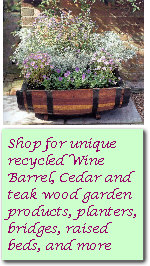Leguminous plants such as beans, peas, clover, alfalfa and
vetch can be grown as a source of nitrogen. Rhizobia bacteria that grow on the
roots of these plants take nitrogen from the air and make it available to the
plant. In turn, the plant gives the Rhizobia the carbohydrates they need to
grow. This give and take between different species is known as a symbiotic
relationship. The seeds should be inoculated (coated) with the proper Rhizobia
before planting to assure higher rates of nitrogen fixation.
Growing Nitrogen in the Garden:
Interplant vegetable crops with with peas and beans. In late
summer and early fall, thickly plant peas between crop rows or in open spaces.
The best time for tilling legumes into the soil is before they bloom. Then, the
plants are most leafy and richest in nitrogen.
A cover crop adds nutrients and organic matter to the soil and
decreases soil erosion. If an area of the garden will not be cultivated, in
spring sow a leguminous cover crop such as alfalfa, fava beans or clover. In
early autumn, clover or hairy vetch can be sown once crops are harvested. Where
fall crops are still growing, you can sow a cover crop a month or less before
the vegetable harvest. This way the cover crop gets a good start but does not
interfere with the edible crop. Do not allow these cover crops to set seed as
they can become invasive.
Growing Nitrogen Outside the Garden:
Where garden space is limited, grow vetch, alfalfa, beans or
peas along yard borders or fences as a source of green manure or high nitrogen
organic matter. Leguminous crops can also be grown in parts of your yard instead
of a grass lawn or in a section of the garden that is not being used. Adding
only phosphorus fertilizer (no nitrogen) will favor legume growth over grasses
and weeds. Legumes also grow best in well-limed soil.
Leguminous plants can be mowed, raked, and added to the
compost pile, used as a mulch, or turned directly into the garden soil. Plant
your vegetables where the legumes were planted the previous year(s).
![]() Gardeners' Corner
Kids'
Garden
Sustainable Garden
Contact Us
Gardeners' Corner
Kids'
Garden
Sustainable Garden
Contact Us![]()


